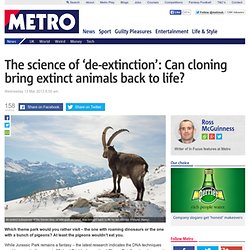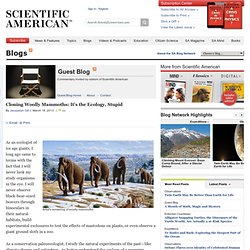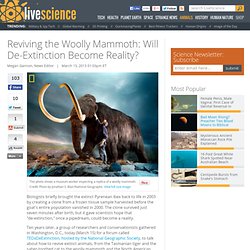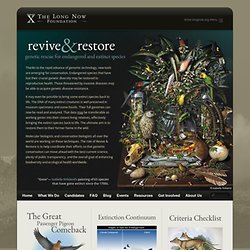

The science of 'de-extinction': Can cloning bring extinct animals back to life? Which theme park would you rather visit – the one with roaming dinosaurs or the one with a bunch of pigeons?

At least the pigeons wouldn’t eat you. While Jurassic Park remains a fantasy – the latest research indicates the DNA techniques used to recreate dinosaurs in Michael Crichton’s novel and Steven Spielberg’s subsequent movie are not possible – scientists are confident they can bring back an extinct bird. Cloning Woolly Mammoths: It’s the Ecology, Stupid.
Artist's rendering of woolly mammoths.

As an ecologist of ice age giants, I long ago came to terms with the fact that I will never look my study organisms in the eye. I will never observe black-bear-sized beavers through binoculars in their natural habitats, build experimental exclosures to test the effects of mastodons on plants, or even observe a giant ground sloth in a zoo. As a conservation paleoecologist, I study the natural experiments of the past—like climate change and extinction—to better understand the ecology of a warming, fragmented world. Admitedly, part of the appeal of the ice age past is the challenge of reconstructing long-disappeared landscapes from fragments like pollen, tiny fragments of charcoal, and bits of leaves preserved in lakes.
In the absence of mammoths, for example, I rely instead on spores of fungi that once inhabited their dung. Fig2.jpg (448×299) Will We Kill Off Today's Animals If We Revive Extinct Ones? Will De-Extinction Become Reality? Biologists briefly brought the extinct Pyrenean ibex back to life in 2003 by creating a clone from a frozen tissue sample harvested before the goat's entire population vanished in 2000.

The clone survived just seven minutes after birth, but it gave scientists hope that "de-extinction," once a pipedream, could become a reality. Ten years later, a group of researchers and conservationists gathered in Washington, D.C., Friday (March 15) for a forum called TEDxDeExtinction, hosted by the National Geographic Society, to talk about how to revive extinct animals, from the Tasmanian tiger and the saber-toothed tiger to the woolly mammoth and the North American passenger pigeon. Though scientists don't expect a real-life "Jurassic Park" will ever be on the horizon, a species that died a few tens of thousands of years ago could be resurrected as long as it has enough intact ancient DNA.
Video: Why We're Obsessed With Zombies Ways Nature Fakes It. De-extinction isn’t a good idea. Photo by Wade Payne/AP A few weeks back I chanced across a post by Carla Sinclair at BoingBoing in which she recounted a TED talk that proposed reviving extinct species: “Stewart Brand began his TED talk today with the statement, ‘Biotechnology is about to liberate conservation.’* Before I had a chance to process what that meant, he went on to list a number of birds and mammals that have become extinct in the last few centuries, including the passenger pigeon, which was killed off by hunters in the 1930s.

For a moment my mood plunged, as it always does with conversations of human-caused animal extinction. And then he asked the question, ‘What if DNA could be used to bring a species back?’ I felt a tsunami of awe and excitement barrel through the audience. So far, the usual dewy-eyed gravitas we’ve come to expect from TED talks. “Genomic technology and techniques are advancing rapidly. So far, revivification of extinct species has limited success.
De-Extinction - Bringing Extinct Species Back to Life - Pictures, News, TEDx Conference. Bringing Extinct Species Back to Life. On July 30, 2003, a team of Spanish and French scientists reversed time.

They brought an animal back from extinction, if only to watch it become extinct again. The animal they revived was a kind of wild goat known as a bucardo, or Pyrenean ibex. The bucardo (Capra pyrenaica pyrenaica) was a large, handsome creature, reaching up to 220 pounds and sporting long, gently curved horns. For thousands of years it lived high in the Pyrenees, the mountain range that divides France from Spain, where it clambered along cliffs, nibbling on leaves and stems and enduring harsh winters.
Then came the guns. But Celia’s cells lived on, preserved in labs in Zaragoza and Madrid. 24 Animals For De-Extinction. The Last Great Auk. The black and white Great Auk was a beautiful bird of bizarre proportions.

Its ribbed beak was huge and unwieldy, its legs were too short and its stubby wings were far too small to carry its big body into the air. In these regards, the Great Auk’s clumsy appearance rivals that of the Dodo. And that’s not the only thing these two birds have in common. For the Great Auk too, was driven extinct by human cruelty and carelessness. The Icelandic fishermen Sigurðr Islefsson, Jón Brandsson and Ketil Ketilsson saw the last living Great Auks, in June 1844. Almost tangible, but not quite. Life. Extinct Species That Could Be Brought Back. Photograph by Jonathan S. Blair, National Geographic A museum worker inspects a replica of a woolly mammoth ( Mammuthus primigenius) , a species that went extinct 3,000 to 10,000 years ago . In March 2012, scientists in Russia and South Korea announced a partnership to try to clone the mammoth and generate a living specimen.
Henson-Sabertoothed. Reviving the Woolly Mammoth: Will De-Extinction Become Reality? Biologists briefly brought the extinct Pyrenean ibex back to life in 2003 by creating a clone from a frozen tissue sample harvested before the goat's entire population vanished in 2000.

The clone survived just seven minutes after birth, but it gave scientists hope that "de-extinction," once a pipedream, could become a reality. Ten years later, a group of researchers and conservationists gathered in Washington, D.C., today (March 15) for a forum called TEDxDeExtinction, hosted by the National Geographic Society, to talk about how to revive extinct animals, from the Tasmanian tiger and the saber-toothed cat to the woolly mammoth and the North American passenger pigeon.
Raising The Mammoth – Russian And Korean Scientists Set Out To Bring Back The Extinct Giant. By recovering well-preserved mammoth tissue, like 40,000 year old baby mammoth Lubya, scientists hope to clone the extinct beast and then birth one via an elephant.

South Korean and Russian scientists have agreed on a project right out of “Jurassic Park.” Maybe not as cool as resurrecting T. Rex, but bringing back a woolly mammoth is sure to attract paying customers. On March 13th, South Korean and Russian scientists agreed on a joint venture to do exactly that. According to the agreement, the Russian team will collect biological samples and send them to the Korean team for processing. Pretty straightforward, right? The biggest challenge right now is to find tissue and isolate cells that have healthy DNA, undamaged from freezing or radiation produced from the ground. 06-russian-renewal-670. It's Called 'De-Extinction' — It's Like 'Jurassic Park,' Except It's Real : The Picture Show.
Sorry to disappoint, but science writer Carl Zimmer says we're not going to bring back dinosaurs.

But, he says, "science has developed to the point where we can actually talk seriously about possibly bringing back more recently extinct species. " It's called "de-extinction" — and it's Zimmer's cover story for National Geographic's April issue. Resurrection Tintypes To capture the mood of this story, National Geographic hired tintype photographer Robb Kendrick. He used a nearly extinct photo technique to capture museum exhibits of extinct species. Extinct species back to life. The GreatPassenger PigeonComeback Male passenger pigeon, painting by Tim Hough.

News & updates on the project using museum-specimen DNA to bring this iconic species all the way back. Extinction Continuum Learn about the genetic situation of a variety of endangered and extinct animals and how biotechnologies might be applied. The Narcissism of De-Extinction. The TedxDeExtinction conference, discussing how and whether to resurrect extinct species from DNA, took place on the Ides of March 2013 at the National Geographic headquarters in Washington, DC. Watch archived versions of the talks. Passenger pigeon. Photo Credit: Biodiversity Heritage Library If people had the ability to resurrect extinct species (dubbed “de-extinction”) and reintroduce them to the wild, should we direct our energy and resources towards it? I will admit my bias straight off: I’m skeptical of the utility of resurrecting extinct species for a multitude of reasons.
But the main thing that bugs me is the blatant narcissism and anthropocentrism behind it. Passenger pigeons. This morning, speaker Mike Archer argued that resurrecting extinct species is worth doing to “restore the balance of nature that we have upset.” Ecosystems change constantly. Opinion: The Case Against Species Revival. Editor's note: Stuart Pimm is the Doris Duke Chair of Conservation Ecology at Duke University, and the 2006 laureate of the Dr. A. H. Heineken Prize for Environmental Sciences awarded by the Royal Netherlands Academy of Arts and Sciences. De-Extinction - The April Cover of National Geographic Magazine Explores the Possibility of Reviving Extinct Species - National Geographic.
Giant sloth When it went extinct: About 11,000 years ago How: Hunting by humans Where it lived: The Americas Size: As long as 20 feet, up to 9,000 pounds Diet: Ate plants but also scavenged for meat Random fact: Had claws as long as 20 inches Why we might be able to bring it back: DNA samples found in fossil dung in Utah Cuban red macaw. Last Tasmanian Tiger, Thylacine, 1933. Tasmanian tiger DNA 'lives' again. Seventy years after the ferocious Tasmanian tiger went extinct, its marsupial DNA has been resurrected inside mice. This is the first time that genetic material from an extinct animal has functioned inside a living host. The technique has huge potential, say the researchers. For instance, it might help to reveal how dinosaurs or Neanderthals looked. Tasmanian Tiger. Buidelwolf. The Lost Tasmanian Tiger (Rare Video)
Buidelrat-450x312. Mysterious Planet: Return of the Thylacine? Buidelwolf. Extinct ibex is resurrected by cloning. It has also increased the possibility that it will one day be possible to reproduce long-dead species such as woolly mammoths and even dinosaurs. Resurrecting the Extinct Frog with a Stomach for a Womb. Two years ago, Mike Archer from the University of New South Wales looked down a microscope and saw that a single fertilised frog egg had divided in two.
Then, it did it again. And again. The Plan to Bring the Iconic Passenger Pigeon Back From Extinction. Twelve birds lie belly-up in a wooden drawer at the Berkeley Museum of Vertebrate Zoology. Bloated with stuffing, their ruddy brown chests resemble a row of sweet potatoes. Slate-blue heads and thin white tails protrude in perfect alignment, except for one bird that cranes its neck to face its neighbor.
How to Resurrect Lost Species. Will we ever see a woolly mammoth again? What's The Half-Life Of DNA? DNA is a sturdy molecule; it can hang around for a long time in fossilized plants and animals.